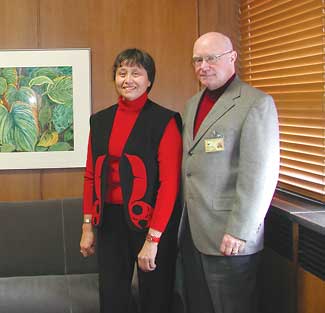Joyce Tinkham, an inpatient unit clerk for pediatric cardio-thoracic Intensive Care Unit (ICU) at U-M Hospital, says the best thing about her job is the evening shift.
 |
|
Joyce Tinkham joins Dr. Robert Kelch in his office, where one of her works of art is displayed. (Photo courtesy Joyce Tinkham)
|
“Ever since I was a kid I wanted to stay up late. Working at night fits in with my biorhythms,” Tinkham says.
When she’s not working, Tinkham, an award-winning artist, immerses herself in paint.
A painting she entered a couple of years ago in the Health System’s Gifts of Art exhibits was purchased by Dr. Robert Kelch, executive vice president for medical affairs. Of the experience, Tinkham says, “It was very exciting. I got to go to his office and have a PR moment with him.”
Tinkham begins her evenings at the hospital by going to each patient’s room and matching statistics such as nurse names, IDs and diets to the day clerk’s report. She takes care of any changes in patients’ diets and also makes IDs and orders supplies if necessary.
“Congenital heart patients are generally diagnosed early, so the patients are usually babies, but once we had a 61-year-old,” she says.
“The staff and surgeons are very good. It is intense, but you can see the patients getting well and leaving the ICU. Babies are often out of the ICU in days. It’s amazing.”

After her high school graduation in 1964, Tinkham began working in her first hospital job at St. Joseph Hospital. “I worked there a couple years and really enjoyed it,” she recalls. She attended the School of Art & Design in the late 1960s. “I graduated from U-M and taught art in an elementary school.” With two small children, she worked weekends as a clerk. “I ended up staying for five years. I just keep coming back to clerking.”
Her mother Vicky Barner was a nurse and so is her daughter Amanda. “It skipped my generation, but I enjoy working in hospitals,” Tinkham says.
Tinkham’s heritage is Nisga’a Native American, a factor that, as she puts it, “creeps into my work.”
“The paintings sometimes have Native American themes, and sometimes American native designs,” she says.
As part of a project to paint Ann Arbor’s light boxes, Tinkham painted the traffic control box on the corner of South University and Washtenaw with Native American women representing the four directions on each side of the box: Nisga’a for north, Cherokee for east, Pueblo for south, and a plains woman on the west side of the box. The entire project, dubbed “Fire Up Downtown,” received a Golden Paintbrush award from the Ann Arbor Commission on Art in Public Places, for its role in beautifying the city. The award was presented at the city council meeting June 1.
Because Tinkham works the evening shifts at the hospital, she focuses on her art in the morning and during vacations. She is a member of the Ann Arbor Fiberarts Guild and has been attending a watercolor camp on Lake Leelanau for the past 20 years. This is where most of her work is accomplished.
“The same 10 ladies have been going every year, so now we’re really close. This year I did six paintings, which was really successful. It didn’t hurt that it rained a lot,” she says laughing.
She’s also a regular contributor to the Gifts of Art program, in its 20th year, which presents local artists’ work in U-M Health System public areas. “I was working here 20 years ago, but didn’t participate. Now I do something every year for the employee art exhibit.”
The weekly Spotlight features staff members at the University. To nominate a candidate, please contact the Record staff at [email protected].

